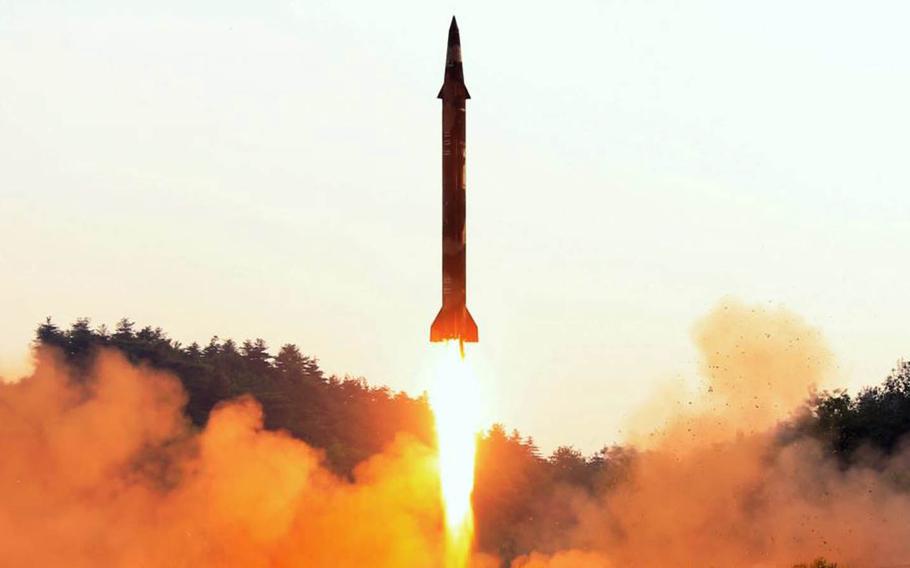
This undated image released in May by the Korean Central News Agency shows a missile being launched from North Korea. (Courtesy of KCNA)
SEOUL, South Korea — South Korea’s president didn’t issue the usual strongly worded condemnation after the North’s latest missile test, which broke a monthlong lull in such activity.
Instead, he called for patience.
The White House, meanwhile, said President Donald Trump was briefed on the launches, which occurred five days after U.S.-South Korean war games began on the divided peninsula despite warnings from the North that it would retaliate against them.
North Korea fired three short-range ballistic missiles in a half-hour timespan on Saturday, with one blowing up immediately after launch and the other two flying about 155 miles in a northeastern direction, according to U.S. Pacific Command. It stressed they posed no threat to the U.S. territory of Guam, which was the focus of a recent crisis between the two sides.
South Korean officials said the projectiles were apparently fired as part of North Korea’s efforts to expand the range of its 300 mm rocket artillery system. Both countries said they were still analyzing the situation and couldn’t immediately provide more details.
Saturday’s barrage — North Korea’s first since it test-fired an intercontinental ballistic missile on July 28 — threatened to renew tensions that have begun subsiding after Trump and Pyongyang engaged in a war of words that raised fears of a new conflict on the divided peninsula.
But the relatively muted response from Washington and Seoul suggests efforts to restore calm and leave the door open for Pyongyang to move onto a diplomatic track are continuing.
South Korea’s presidential office convened a National Security Council meeting to discuss the launches, although Moon Jae-in did not attend. Participants “decided to proceed more thoroughly with the ongoing UFG drills,” spokesman Yoon Young-chan said.
He was referring to joint military exercises known as Ulchi Freedom Guardian, which began Aug. 21 and are due to end Thursday. The computerized war games — as well as a round of springtime drills — are conducted annually by the United States and South Korea and always infuriate the North, which considers them a rehearsal for an invasion.
Moon later called for patience, saying problems between the two Koreas cannot be resolved right away.
Trump didn’t tweet about the North’s activities as he has in the past, although the White House said he had been briefed, adding “we are monitoring the situation.”
Both Trump and Secretary of State Rex Tillerson praised the North last week for not staging a major provocation amid fears it would conduct a sixth nuclear test or follow through with a plan to fire missiles into the waters near Guam.
North Korea has frequently tested short-range missiles and conducted other low-level provocations, although experts caution its scientists learn from every effort.
Experts note the long-running standoff over the North’s nuclear ambitions has risen to the point of crisis frequently in the past only to see the sides back away from the brink of conflict.
But concern has spiked as the communist state has stepped up the pace of its nuclear weapons program over the past year and a half in its bid to develop the capability to target the U.S. mainland, despite punishing U.N. Security Council economic sanctions and growing pressure even from its only major ally, China.
Many North Korea observers also worry that a miscalculation could accidentally push the sides into a full-fledged conflict.
Trump has bounced between harsh rhetoric, including a warning that he’ll unleash “fire and fury” on the North if it continues to threaten the United States, and hints that he’d be willing to talk to Kim Jong Un himself under the right conditions.
The president made hopeful remarks about Kim last week, telling supporters in Arizona that “I respect the fact that he is starting to respect us” and “maybe – probably not, but maybe – something positive can come about.”
Tillerson also welcomed what he called a “level of restraint” from the North Korean regime.
“This is the beginning of this signal that we’ve been looking for … that perhaps we are seeing our pathway to sometime in the near future having some dialogue,” he told reporters in Washington on the same day as Trump’s remarks.
Moon, who took office on May 10 promising a more peaceful approach toward the North, has found himself caught in the middle as he pursues a dual track of seeking dialogue while maintaining pressure.
His administration has proposed bilateral talks with the North, which have so far been rebuffed. But the liberal leader also has warned the development of a nuclear-tipped ICBM would be a “red line.”
“Evaluations of (policies regarding) South-North relations don’t come out quickly, hence this one must be prepared with a long-term perspective,” Moon said Saturday during a meeting with lawmakers, according to the Yonhap News Agency.
North and South Korea have been divided by the world’s most fortified border since their 1950-53 war ended in an armistice instead of a peace treaty. About 28,500 U.S. servicemembers are based in the South.
Twitter: @kimgamel